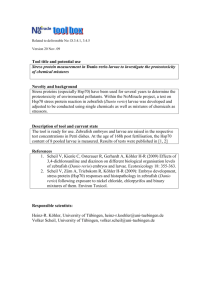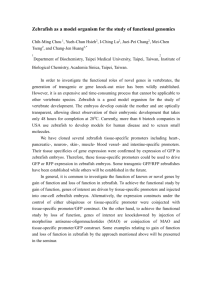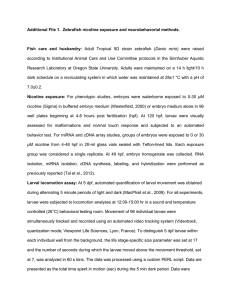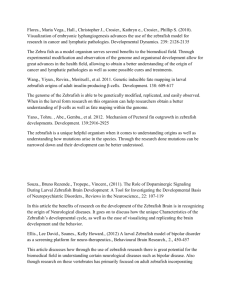Immunohistochemical Characterization of Intestinal Neoplasia in
advertisement
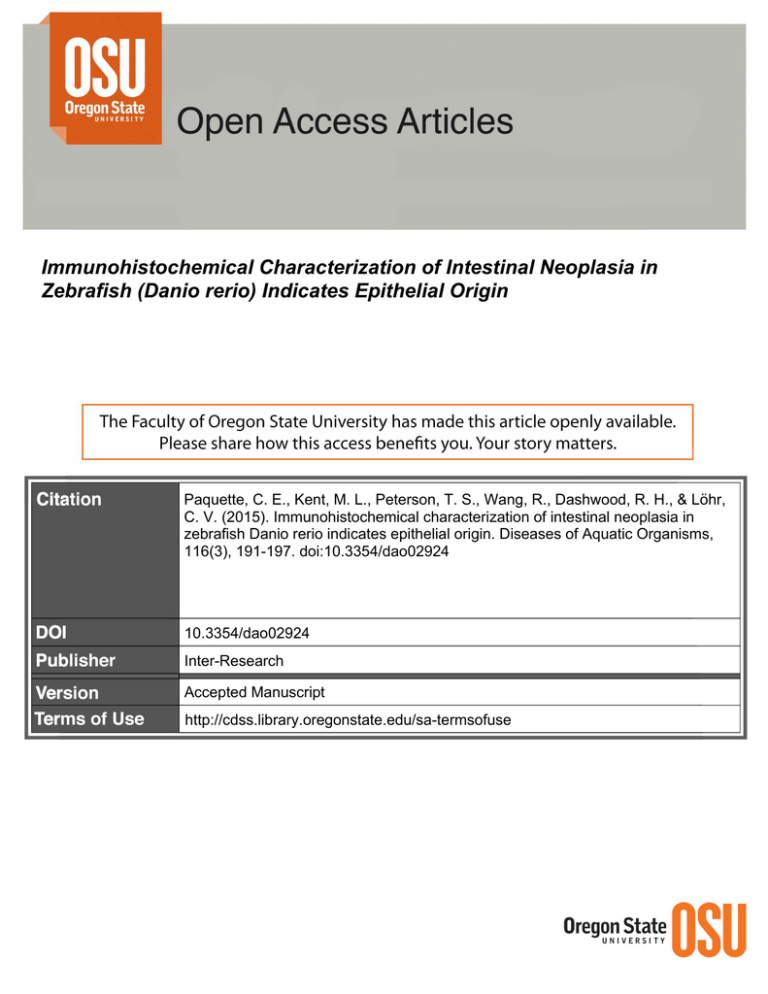
Immunohistochemical Characterization of Intestinal Neoplasia in Zebrafish (Danio rerio) Indicates Epithelial Origin Paquette, C. E., Kent, M. L., Peterson, T. S., Wang, R., Dashwood, R. H., & Löhr, C. V. (2015). Immunohistochemical characterization of intestinal neoplasia in zebrafish Danio rerio indicates epithelial origin. Diseases of Aquatic Organisms, 116(3), 191-197. doi:10.3354/dao02924 10.3354/dao02924 Inter-Research Accepted Manuscript http://cdss.library.oregonstate.edu/sa-termsofuse 1 1 Immunohistochemical Characterization of Intestinal Neoplasia in Zebrafish (Danio rerio) 2 Indicates Epithelial Origin 3 Colleen E. Paquette1, Michael L. Kent 1 Tracy S. Peterson1, Rong Wang2, Roderick H. 4 Dashwood2, Christiane V. Löhr3* 5 6 7 1 Department of Microbiology, Oregon State University, Corvallis, Oregon 8 2 Linus Pauling Institute, Oregon State University, Corvallis, Oregon 9 3 Department of Biomedical Sciences, College of Veterinary Medicine, Oregon State University, 10 Corvallis, Oregon 11 C. Paquette is now at the Translational Imaging Center, University of Southern California, Los 12 Angeles, California. 13 Dr. Peterson is now at the University of Arkansas Regulatory Science Center, Pine Bluff, 14 Arkansas. 15 Dr. Dashwood is now at the Center for Epigenetics & Disease Prevention, Texas A&M Health 16 Science Center, Houston, Texas 17 18 *Corresponding Author: 19 Christiane V. Löhr 20 Department of Biomedical Sciences 21 Oregon State University 22 106 Dryden Hall 23 Corvallis, Oregon 97331-4801 2 1 Telephone: 541-737-9673 2 Fax: 541-737-2730 3 Email: Christiane.Loehr@oregonstate.edu 4 5 ABSTRACT: Spontaneous neoplasia of the intestinal tract in sentinel and moribund zebrafish 6 (Danio rerio) is common in some zebrafish facilities. We previously classified these tumors as 7 adenocarcinoma, small-cell carcinoma, or carcinoma otherwise unspecified based on 8 histomorphologic characteristics. Based on histological presentation, the primary differential 9 diagnosis for the intestinal carcinomas was tumor of neuroendocrine cells (e.g., carcinoids). To 10 further characterize the phenotype of the neoplastic cells, select tissue sections were stained with 11 a panel of antibodies directed toward human epithelial (Cytokeratin Wide Spectrum Screening 12 [WSS], AE1/AE3) or neuroendocrine (S100, chromogranin A) markers. We also investigated 13 antibody specificity by Western blot analysis, using a human cell line and zebrafish tissues. Nine 14 of the intestinal neoplasms (64%) stained for AE1/AE3, seven (50%) also stained for WSS. 15 None of the intestinal neoplastic cells were stained for chromogranin A or S100. Endocrine cells 16 of the pituitary gland and neurons and axons of peripheral nerves and ganglia stained for 17 Chromogranin A, whereas perineural and periaxonal cells of peripheral intestinal ganglia, and 18 glial and ependymal cells of the brain stained for S100. Immunohistochemistry for cytokeratins 19 confirmed the majority of intestinal neoplasms in this cohort of zebrafish as carcinomas. 20 21 Running page head 22 Intestinal carcinomas in zebrafish 23 3 1 Keywords 2 carcinoma, cytokeratin, immunohistochemistry, intestine, neoplasia, Western blot, zebrafish 3 4 INTRODUCTION 5 For over a decade, spontaneous intestinal neoplasia has been observed in zebrafish 6 (Danio rerio) submitted to the ZIRC (Zebrafish International Resource Center) diagnostic 7 service (Spitsbergen et al. 2012, Paquette et al. 2013). Many of the fish from these populations 8 also displayed preneoplastic changes in the intestine, including epithelial hyperplasia and 9 dysplasia. Based on routine histology, neoplastic lesions were classified either as 10 adenocarcinoma (50 %) or small cell carcinoma (37%), with a few exceptions (carcinoma, 11 tubular adenoma, and tubulovillous adenoma=12 %) (Paquette et al. 2013). 12 The cellular phenotype of these neoplasms has not been fully elucidated. Considering the 13 location and morphology, the primary alternative to intestinal carcinomas are small cell 14 carcinoma or carcinoid tumors derived from neuroendocrine cells (Klöppel & Anlauf 2005, 15 Modlin et al. 2008). The purpose of this study was to more fully characterize zebrafish intestinal 16 tumors using immunohistochemistry. There is close conservation between human and zebrafish 17 tumorigenic mechanisms at the molecular, cellular, and tissue levels, including expression of 18 tumor antigen target epitopes (Amatruda & Patton 2008, Liu & Leach 2011). Based upon 19 interspecies target epitope conservation and the limited availability of zebrafish-specific 20 antibodies, we chose to evaluate tumor antigen expression using antibodies raised against human 21 antigens. Both WSS and AE1/AE3 are cytokeratin markers expressed in human intestinal 22 adenocarcinomas (Chu & Weiss 2002). S100 is a marker for neural crest-derived-cells found in 23 human neurogenic neoplasms (e.g., schwannoma, melanoma, ependymoma, astroglioma) and 4 1 gastrointestinal stromal tumors (GISTs) (Miettinene & Lasota 2001). Chromogranin A is 2 expressed in chromaffin cells of endocrine and neuroendocrine origin and their respective 3 neoplasms, such as pheochromocytoma and small-cell carcinomas (Ferrari et al. 1999). In 4 addition, WSS and AE1/AE3 cytokeratins, S100 and chromogranin A antibodies were evaluated 5 by Western blotting, in order to compare and contrast differences, if any, between the respective 6 human and zebrafish proteins. 7 8 MATERIALS AND METHODS 9 Cases 10 A subset of paraffin-embedded sentinel and moribund zebrafish, previously fixed with 11 Dietrich’s, was selected from the archive at the ZIRC diagnostic service, based upon the 12 presence of intestinal tumors previously classified as adenocarcinoma, small-cell carcinoma, or 13 carcinoma (Paquette et al. 2013). These specimens demonstrated distinct histomorphologic 14 characteristics of the comparative mammalian tumors (Lingeman & Garner 1972, Sidhu 1979, 15 Brenner et al. 2004), determined using routine hematoxylin and eosin-stained slides. 16 17 Western Blotting 18 Five whole frozen zebrafish approximately 30 days post fertilization (dpf) were 19 processed for immunoblot analyses. The animals were pooled and homogenized with IP lysis 20 buffer (Roche, Indianapolis, IN 46250) and incubated overnight at 4 °C. Protein concentration 21 was determined using the Thermo Scientific Pierce Micro BCA protein assay (Thermo 22 Scientific, Rockford, IL 61105), with bovine serum albumin as standard. Zebrafish protein 23 samples were then prepared and separated by electrophoresis on a SDS-PAGE gel using 5 1 MagicMarkTM XP Western Protein Standard (Life Technologies, Carlsbad, CA 92008) and 2 human acute monocytic leukemia cell line HTP-1 (ATCC® TIB-202™American Type Culture 3 Collection, Manassas, VA 20108) as positive controls. Proteins were transferred onto a 4 nitrocellulose membrane (Life Technologies, Carlsbad, CA 92008) and blocked by immersion in 5 2% BSA (bovine serum albumin) dissolved in phosphate buffered saline (PBS). The membranes 6 were then incubated at 4 °C overnight with the primary antibodies against WSS (Dako Z0622) 7 1:2000, AE1/AE3 (Dako M3515) 1:400, S100 (Dako Z0311) 1:500 or chromogranin A (Dako 8 A0430) 1:2000 (Dako - Agilent Technologies, Carpinteria, CA 93013). After incubation, the 9 membranes were washed with PBS containing 0.1% Tween-20 six times and incubated for 1 h 10 with a secondary antibody of goat anti-rabbit IgG-HRP (WSS, S100, and chromogranin A) or 11 goat anti-mouse IgG-HRP (AE1/AE3) (Dako - Agilent Technologies, Carpinteria, CA 93013). 12 Membranes were subsequently washed with PBS containing 0.1% Tween-20 three times. 13 Substrate development for photo documentation was performed using the PierceTM ECL 14 chemiluminescent substrate (Thermo Scientific, Rockford, IL 61105). 15 16 Immunohistochemistry 17 Immunohistochemistry was performed according to Standard Operating Procedures of 18 the Veterinary Diagnostic Laboratory at Oregon State University. In brief, 4-5 µm sections on 19 charged slides (Tanner Scientific, Sarasota, FL 34243) were rehydrated. Slides were either high 20 temperature antigen retrieved (Chromogranin A-Dako A0430 [1:1000]; S100-Dako Z0311 21 [1:400]) in a microwave pressure cooker for 10 minutes or enzymatically digested with 22 Proteinase K (Dako S3020) for 5 minutes (CK(WSS)-Dako Z0622 [1:500]; AE1/AE3-Dako 23 M3515 [1:100]). In a Dako Autostainer primary antibodies were applied for 30 minutes at room 6 1 temperature followed by MaxPoly-One polymer HRP rabbit or mouse (MaxVision Biosciences, 2 Kenmore, WA, 98028) for 10 minutes at room temperature. Signal was developed with 3 chromogen Nova Red (Vector Laboratories, SK-4800, Burlingame, CA 94010) and slides were 4 counterstained with Dako hematoxylin (s3302). Sections of whole zebrafish served as positive 5 and negative controls for immunohistochemistry. 6 Considering the subjectivity in evaluation of immunohistochemistry results, the slides 7 were read independently by three of the authors (C.P., M.K., and C.L.). Results were recorded 8 as follows for each antibody; + = positive, +/- = weak staining or few neoplastic cells showing 9 positivity, and - = negative (Table 1). 10 11 RESULTS 12 Cases 13 The fish selected for analysis were sourced from six individual facilities and included 14 seven females and seven males, ranging in age from 301-1071 dpf. Both wild-type and mutant 15 lines were represented. Six tumors were located in the anterior third of the intestine, seven were 16 mid-intestine, and one was located in the mid-distal intestine. Four of the tumors analyzed were 17 classified as adenocarcinoma, five as small-cell carcinoma, and five as carcinoma not otherwise 18 specified. 19 20 21 Western Blotting In proteins from whole zebrafish homogenate, WSS stained two distinct bands at 22 approximately 40 kDa, while a series of bands 48-59 kDa was expected and observed with the 23 human cell homogenate (Adem et al. 2002, Chu & Weiss 2002) (Fig. 1a). AE1/AE3 recognized 7 1 several zebrafish protein bands between approximately 38 and 41 kDa, whereas a series of bands 2 approximately 40 and 48-67 kDa was expected and observed with the human cells (Woodcock- 3 Mitchell et al. 1982, Chu & Weiss 2002) (Fig. 1b). S100 produced a weak distinct band at 4 approximately 10 kDa, compared to the approximate 21 kDa for human protein (Singh & Cheng 5 1996) (Fig. 1c). Chromogranin A recognized a band at approximately 44 kDa in the zebrafish 6 tissue and at the expected 74 kDa in the human cells (Montero-Hadjadje et al. 2008) (Fig. 1d). 7 8 9 10 11 Immunohistochemistry The expression of WSS, AE1/AE3, S100, and chromogranin A antibodies was analyzed 12 in normal tissue and tissue from intestinal tumors from 14 individual zebrafish. Intestinal tumors 13 included adenocarcinoma (Fig. 2a+c), small-cell carcinoma (Fig. 2b+d), and carcinoma. 14 Strong staining for WSS was present in normal epithelial cells of the intestine (Fig. 3a), 15 skin, nares, and gills (Fig. 3b), and renal collecting ducts of adult zebrafish, serosal cells of the 16 coelomic cavity and meninges, and cross-reacted with chondrocytes and endothelium. Neural 17 tissue and exocrine pancreas were negative. AE1/AE3 demonstrated the same staining pattern as 18 WSS including staining of epithelial cells of the intestine and gills (Fig. 3c and Fig. 3d, 19 respectively) and no staining of nervous tissue and exocrine pancreas. However, WSS produced 20 a stronger staining reaction in epithelial cells and less intense cross-reactivity in endothelial cells 21 than AE1/AE3. Seven of the fourteen (50%) intestinal neoplasms scored positive for WSS (Fig. 22 3e), nine of the fourteen (64%) were positive for AE1/AE3 (Fig. 3f) (Table 1). 23 8 1 Chromogranin A reacted positively with a scattered neurons of vertebral ganglia, most 2 cells in the pituitary gland, some nerve fibers in the normal brain and spinal cord, axons and/or 3 sheath cells in peripheral nerves, and thin fibers in the lateral line, sensory organs of the skin and 4 along the cutaneous basement membrane, skeletal muscle, and myenteric plexus (Fig. 3g). 5 Staining intensity was stronger for the latter. Normal intestinal epithelium was negative. All of 6 the intestinal tumors were regarded as negative for chromogranin A (Fig. 3g). 7 In normal zebrafish tissue, S100 antibody showed strong immunoreactivity with glial 8 cells in the nervous tissue including vertebral and myenteric ganglia (Fig. 3h), the nasal 9 epithelium, meninges, thin fibers in the lateral line, skeletal musculature, and individual cells in 10 occasional renal tubules, and weak reactivity in endocrine cells of the pituitary gland. Normal 11 intestinal epithelium was negative for S100. All intestinal tumors were scored negative for S100 12 (Fig. 3h), except for two carcinomas designated “+/-” (faint) by two of the evaluators. 13 14 15 16 DISCUSSION We recently reported, in a retrospective survey of the ZIRC diagnostic database, on the 17 occurrence of intestinal tumors among zebrafish from several laboratories (Paquette et al. 2013). 18 Some laboratories exhibited a high prevalence, and the majority of the intestinal tumors within 19 that study were classified as adenocarcinomas, small-cell carcinomas, or carcinomas otherwise 20 unspecified based upon histomorphology. Immunohistochemical analysis reported here indicates 21 that most, if not all, of the neoplasms are of epithelial origin. Two thirds of the intestinal 22 zebrafish tumors were positive for cytokeratins, while none stained strongly positive with neural 23 tissue markers. Neoplastic cells in the small cell carcinomas were more often negative for the 9 1 two epithelial antibodies. These cells are morphologically less differentiated, with a small 2 nucleus and minimal cytoplasm. 3 It is not surprising that not all intestinal carcinomas stained for cytokeratins. Poor 4 differentiation and progression towards anaplasia or tumor formation from pluripotent blast cells 5 (Kapoor & Khanna 2004) is associated with expression patterns of intermediate forms that are 6 untypical for a particular cell type. Stratification of expression can be observed even amongst 7 neoplastic cells within the same tumor (Chu & Weiss 2002) and may be required for critical steps 8 in tumor progression such as cell invasion (Gabbert et al. 1985). Specific protein bands for WSS 9 and AE1/AE3 were detected in the prepared homogenates of adult zebrafish and human HTP-1 10 cells, albeit 11-16 kDa below their predicted molecular weights in zebrafish tissue. AE1 and AE3 11 have been previously characterized by complimentary keratin blot-binding analysis (Conrad et 12 al. 1998) and S100 by Western blot (Germanà et al. 2007). The small size of zebrafish allows for 13 preparing one histologic slide containing all representative tissues from entire organ systems. 14 This provides an excellent format for positive and negative controls for immunohistochemistry, 15 as appropriate normal tissues are present in the exact specimen as the tissue of interest. In our 16 study, a wide variety of epithelial cells were strongly positive with both cytokeratin stains. 17 Cells of gut derived neuroendocrine neoplasms in vertebrates often stain for S100 and 18 chromogranin A, particularly with the latter marker (Bunton 1994, Ferrari et al. 1999, Jirásek & 19 Mandys 2003, Modlin et al. 2008, Giandomenico 2010). None of the tumors examined here had 20 convincing staining for either of the two neural/neuroendocrine markers. Considering the caveats 21 detailed for cytokeratin staining above, this indicates that the intestinal tumors of zebrafish 22 examined here are most likely not of neuroendocrine origin. Mammalian S100 antibody has 23 been shown to cross-react with zebrafish schwannomas (Marino et al. 2012), and also stains 10 1 neural tissues in zebrafish and other fishes (Masahito et al. 1985, Bunton & Wolfe 1996, Manso 2 et al. 1997, Bunton 2000, Sakamoto & White 2002, Marino et al. 2007). However, it did not 3 cross-react in a dysembryoplastic neuroepithelial tumor of zebrafish that we recently described 4 (Peterson et al. 2012). 5 Chromogranin A rabbit antibodies have not previously been investigated with the 6 zebrafish model. Here, we observed specific staining of neural tissues, particularly in nerve 7 ganglia and the pituitary gland. In contrast, none of the neoplasms exhibited staining for this 8 antibody. By immunoblot analysis, chromogranin A expressed a distinct band at ~44 kDa, which 9 was lower than the predicted zebrafish chromogranin A molecular weight, based on sequence 10 data (Montero-Hadjadje et al. 2008), but similar to that observed in brown bullhead (Bunton 11 2000). 12 Western blots for S100 and chromogranin A produced only weak bands and only the 13 former appeared at the expected size. The other three antibodies consistently reacted to produce 14 protein bands 11-16 kDa below their expected molecular weights against the zebrafish tissue 15 (Conrad et al. 1998, García et al. 2005, Germanà et al. 2007, Montero-Hadjadje et al. 2008). For 16 most zebrafish proteins, only molecular weight estimations based on amino acid sequence are 17 available. However, additional support for the immunoblot findings might be obtainable using 18 PCR and genetic analysis of the zebrafish proteins. 19 Antibodies directed at mammalian proteins are not optimized for use on zebrafish tissue 20 sections, and even certain antibodies generated against other teleost fish have shown markedly 21 reduced affinity for zebrafish antigens (García et al. 2005). Moreover, the few zebrafish-specific 22 antibodies that have been developed to date have not been optimized or appropriately validated 23 (Feitsma & Cuppen 2008). Nevertheless, given the morphology and location of the neoplastic 11 1 cells, and our results with immunohistochemistry, we conclude that most, if not all, of the 2 commonly observed intestinal tumors seen in zebrafish are derived from epithelial cells. 3 4 Acknowledgements. This study was supported by departmental funds (to CE Paquette), NIH 5 NICHD #P01HD22486, NIH OD P40 RR012546, 2R24OD010998-11, CA090890, CA122959, 6 and NIEHS Environmental Health Science Center #P30 ES000210. 7 8 9 10 11 12 13 14 15 16 17 18 19 20 21 22 23 24 25 26 27 28 29 30 31 32 33 34 35 36 37 LITERATURE CITED Adem C, Reynolds C, Adlakha H, Roche P C, Nascimento AG (2002) Widespectrum screening keratin as a marker of metaplastic spindle cell carcinoma of the breast: an immunohistochemical study of 24 patients. Histopathology 40:556-562 Amatruda JF, Patton EE (2008) Genetic models of cancer in zebrafish. Int Rev Cell Mol Biol 271:1-34 Brenner B, Tang LH, Klimstra DS, Kelsen DP (2004) Small-cell carcinomas of the gastrointestinal tract: A review. J Clin Oncol 22:2730-2739 Bunton TE (1994) Tumor immunodiagnosis in fish. In: Gardner HS, comp. Compendium of the FY1990 and FY1992 Research Reviews for the Research Methods Branch. Fort Detrick, MD: Army Biomedical Research and Development Lab, p 97-99 Bunton TE, Wolfe MJ (1996) Reactivity of tissue-specific antigens in N-methyl-N'nitro-N nitrosoguanidine-induced neoplasms and normal tissues from medaka (Oryzias latipes). Toxicol Pathol 24:331-338 Bunton TE (2000) Brown bullhead (Ameiurus nebulosus) skin carcinogenesis. Exp Toxicol Pathol. 52:209-220 Chu PG, Weiss LM (2002) Keratin expression in human tissues and neoplasms. Histopathology 40:403-439 Conrad M, Lemb K., Schubert T, Markl, J (1998) Biochemical identification and tissue-specific expression patterns of keratins in the zebrafish Danio rerio. Cell Tissue Res 293:195-205 Feitsma H, Cuppen E (2008) Zebrafish as a cancer model. Mol Cancer Res 6:685-694 12 1 2 3 4 5 6 7 8 9 10 11 12 13 14 15 16 17 18 19 20 21 22 23 24 25 26 27 28 29 30 31 32 33 34 35 36 37 38 39 40 41 42 43 44 45 46 Ferrari L, Seregni E, Bajetta E, Martinetti A, Bombardieri E (1999) The biological characteristics of chromogranin A and its role as a circulating marker in neuroendocrine tumours. Anticancer Res 19:3415-3428 Gabbert, H, Wagner, R, Moll R, Gerharz CD (1985) Tumor dedifferentiation: an important step in tumor invasion. Clin Exp Metastasis 3:257-279 García DM, Bauer H, Dietz T, Schubert T, Markl J, Schaffeld M (2005) Identification of keratins and analysis of their expression in carp and goldfish: comparison with the zebrafish and trout keratin catalog. Cell Tissue Res 322:245-256 Germanà A, Paruta S, Germanà GP, Ochoa-Erena F J, Montalbano G., Cobo J, Vega JA (2007). Differential distribution of S100 protein and calretinin in mechanosensory and chemosensory cells of adult zebrafish (Danio rerio). Brain Res Rev 1162:48-55 Giandomenico V (2010) Molecular pathology of gastrointestinal neuroendocrine tumours– selected topics. Diagn Histopathol 16:243-250 Jirásek T, Mandys V (2003) Different patterns of chromogranin A and Leu-7 (CD57) expression in gastrointestinal carcinoids: immunohistochemical and confocal scanning microscopy study. Neoplasma 50:1-7 Kapoor BG, Khanna B (2004) Ichthyology Handbook. Narosa Publishing House New Delhi, India Klöppel G, Anlauf M (2005) Epidemiology, tumour biology and histopathological classification of neuroendocrine tumours of the gastrointestinal tract. Best Pract Res Clin Gastroenterol 19:507-517 Lingeman CH, Garner FM (1972) Comparative study of intestinal adenocarcinomas of animals and man. J Natl Cancer Inst 48:325-346 Liu S, Leach SD (2011) Zebrafish models for cancer. Annu Rev Pathol 6:71-93 Marino F, Germanà A, Bambir S, Helgason S, De Vico G, Macrì B. (2007) Calretinin and S‐100 expression in goldfish, Carassius auratus (L.), schwannoma. J Fish Dis 30:251-253 Marino F, Lanteri G, Rapisarda G, Perillo A., Macrì B (2012) Spontaneous schwannoma in zebrafish, Danio rerio (Hamilton). J Fish Dis 35:239-242 Manso MJ, Becerra M, Becerra M, Anadón R (1997) Expression of a low-molecular weight (10 kDa) calcium binding protein in glial cells of the brain of the trout (Teleostei). Anat Embryol 196:403-416 Masahito P, Ishikawa T, Yanagisawa A, Sugano H, Ikeda K (1985) Neurogenic tumors in Coho salmon (Oncorhynchus kisutch) reared in well water in Japan. J Natl Cancer Inst 75:779790 13 1 2 3 4 5 6 7 8 9 10 11 12 13 14 15 16 17 18 19 20 21 22 23 24 25 26 27 28 29 30 31 32 33 34 35 36 37 38 Miettinen M, Lasota J (2001) Gastrointestinal stromal tumours-definition, clinical, histological, immunohistochemical, and molecular genetic features and differential diagnosis. Virchows Arch 438:1-12 Modlin IM, Oberg J, Chung DC, Jensen RT, de Herder WW, Thakker RV, Caplin M, Fave GD,Kaltsas GA, Krenning EP, Moss SF, Nilsson O, Rindi G, Salazar R, Ruszniewski P, Sundin A (2008) Gastroenteropancreatic neuroendocrine tumours. Lancet Oncol 9:61-72 Montero-Hadjadje M, Vaingankar S, Elias S, Tostivint H, Mahata SK, Anouar Y (2008) Chromogranins A and B and secretogranin II: evolutionary and functional aspects. Acta Physiol 192:309-324 Paquette CE, Kent ML, Buchner C, Tanguay TL, Guillemin K, Mason TJ, Peterson TS (2013) A retrospective study of the prevalence and classification of intestinal neoplasia in zebrafish (Danio rerio). Zebrafish 10:228-236 Peterson TS, Heidel JR, Murray KN, Sanders JL, Anderson WI, Kent ML (2012) Dysembryoplastic neuroepithelial tumor in a zebrafish (Danio rerio). J Com Pathol 148:220-224 Sakamoto K, White M (2002) Dermal melanoma with schwannoma-like differentiation in a brown bullhead catfish (Ictalurus nebulosus). J Vet Diagn Invest 14:247-250 Sidhu GS (1979) The endodermal origin of digestive and respiratory tract APUD cells. Histopathologic evidence and a review of the literature. Am J Pathol 96:5-17 Singh VK, Cheng JF (1996) Immunoreactive S100 proteins of blood immunocytes and brain cells. Journal Nueroimmunol 64:135-139 Spitsbergen JM, Buhler DR, Peterson TS (2012) Neoplasia and neoplasm associated lesions in laboratory colonies of zebrafish emphasizing key influences of diet and aquaculture system design. ILAR J 53:114-125 Woodcock-Mitchell, J, Eichner R, Nelson WG, Sun TT (1982) Immunolocalization of keratin polypeptides in human epidermis using monoclonal antibodies. J Cell Biol 95:580-588 14 1 2 3 Table 1. Summary of WSS, AE1/AE3, S100, and chromogranin A staining of intestinal tumors in zebrafish submitted to the Zebrafish International Resource Center diagnostic service 20012011a. WSS AE1/AE3 S100 CHROMOGRANIN A Adenocarcinoma +++ +++ - - - - F1 +++ +++ - - - - F2 - - - - - +/- - - F3 - - F4 Small-Cell Carcinoma F5 F6 F7 F8 F9 4 5 6 7 - - - - - - +++ - - +/- +/- +/- +/+/- +/- +/+/- - +++ +++ - - - - - - Carcinoma NOCb +++ +++ - - - - F10 - - + +/- + - - - - F11 + +/- + +++ - - - - F12 +++ +++ +/- - +/- - F13 + +/- + + +/- + +/- +/- - - F14 a In each column, the three symbols represent readings performed by three independent evaluators; + (positive), +/- (equivocal), - (negative) b Carcinoma not otherwise classified 15 a 1 2 3 4 5 6 b c d Fig. 1.Western blot against (a) WSS compared to expected targeted protein sizes (indicated by box) where M=marker protein, Z=normal whole adult zebrafish tissue homogenate, H=HTP-1 cells (human), (b) AE1/AE3 compared to expected targeted protein sizes, (c) S100 compared to expected targeted protein size, and (d) chromogranin A compared to expected targeted protein size. 16 1 2 3 4 5 6 7 8 9 10 11 12 13 14 Fig. 2. Danio rerio, intestine with neoplasia. (a) Fish 1. Intestinal adenocarcinoma with neoplastic cells (arrows) within the lamina propria and muscularis, extending to the serosal layer. HE. (b) Fish 7. Intestinal small cell carcinoma infiltrating the lamina propria with invasion into the muscularis (arrows). HE. (c) Fish 1. Higher magnification of the intestinal adenocarcinoma in (a) shows neoplastic cells forming solid and pseudoacinar structures. (d) Fish 7. Higher magnification of Intestinal small cell carcinoma in (b) shows fusiform neoplastic cells forming small aggregated nests. 17 1 2 3 4 5 6 7 8 9 10 11 12 13 14 15 16 17 Fig. 3. Danio rerio, Immunohistochemistry of intestinal neoplasia and normal structures. (a) Fish 1. Cytokeratin expression in the normal cells of the intestinal epithelium. WSS. (b) Fish 1. Cytokeratin expression in the gill epithelium. WSS. (c) Fish 1. Cytokeratin expression in the normal cells of the intestinal epithelium including mesothelial cells (arrow). AE1/AE3. (d) Fish 1. Cytokeratin expression in the gill epithelium. AE1/AE3. (e) Fish 1. Neoplastic cells (arrows) of the invasive intestinal tumor shown in Fig. 2 a and previously classified as adenocarcinoma based upon histomorphologic characteristics stain for cytokeratin. WSS. (f) Fish 1. Neoplastic cells (arrows) of the same intestinal tumor shown in (e), stain for cytokeratin. AE1/AE3. (g) Fish 1. Neurons of myenteric plexus are stained, whereas neoplastic cells of the adenocarcinoma shown in Fig 2a does not stain. Chromogranin A. (h) Fish 1. Normal ganglion cells of autonomic ganglia expressing positive staining (arrows), whereas neoplastic cells of the intestinal tumor shown in Fig. 2a does not stain. S100.




